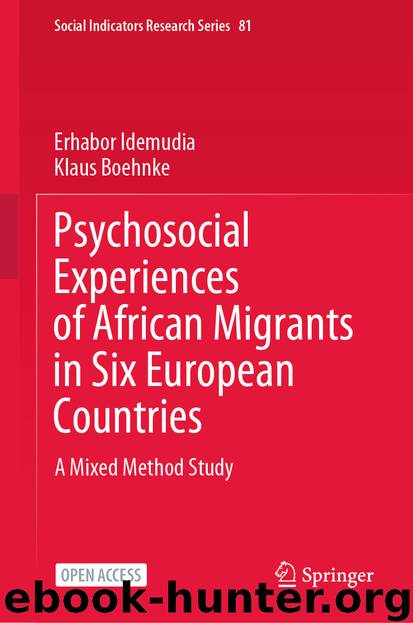Psychosocial Experiences of African Migrants in Six European Countries by Erhabor Idemudia & Klaus Boehnke

Author:Erhabor Idemudia & Klaus Boehnke
Language: eng
Format: epub
ISBN: 9783030483470
Publisher: Springer International Publishing
Demographics, Migrants/Refugees, Migration and Trauma
Unfortunately, risk factors for gender and wellbeing of African migrants are unknown. According to Marshall (1995), gender refers to socially constructed aspects of differences between men and women. Since its introduction as a social concept, it has been extended to refer not only to individual identity and personality but also, the symbolic level, to cultural ideas and stereotypes of masculinity and femininity.
On demographics, Pratchett, Pelcovitz, and Yehuda (2010) suggest sex differences in both prevalence and duration of PTSD. PTSD as a response to trauma is repeatedly found to be more common among women than men (Benedek & Wynn, 2011; Idemudia et al., 2013). Pratchett et al. (2010) also add that women typically experience PTSD symptoms for longer periods than men. Sexual assault is one of the most severe traumatic experiences and has a significantly higher incidence in women. This greater life time exposure to sexual assault among women may explain the higher prevalence of PTSD in women despite the lower overall exposure to traumatic events. Overall, it remains unclear whether there is a “true” gender effect that moderates PTSD risk or instead the increased PTSD risk in women is explained by environmental factors such as the type of trauma.
Mabeya (2017) reported that the “Lost Boys,” Sudanese refugees boys who relocated to the US assisted by the US government as a result of intensely bloody and protracted warfare in their home country then known as Sudan had a bad experience in the US because of their education level. Kagaba (2018) stated that in adjustment to the host country, these immigrants or refugee parents engage in social exchanges, such as with other immigrants or refugees, and resettlement program workers that can self-identify in terms of class, gender, sexual orientation, race and ethnicity, the parents simultaneously utilize their own pre-existing gender boundary negotiation strategies. For instance, parents who used to deal with tribal or religious differences in their homelands are expected to navigate a social context characterized by cultural norms and mores based on their own tribal and/or ethnic differences, various experiences during their displacement, national differences with other immigrant or refugee communities, and the US culture by doing that they engage in bridging multiple simultaneous transnational cultural gaps to the host country. Van der Ven et al. (2016) maintained that psychosis risk among migrants from the Maghreb appears a consistent, foremost among the Moroccan-Dutch: Men from the Maghreb had a significantly higher risk than their European counterparts. In contrast, incidence rates of non-affective psychotic disorder (NAPD) for women from the Maghreb were, with one exception, similar to those for non-migrant women in Europe. Idemudia (2018) report that children who are immigrants are often not hostile to differences because xenophobic tendencies are usually tied to negative stereotypes that exist among adults in the host country.
Download
This site does not store any files on its server. We only index and link to content provided by other sites. Please contact the content providers to delete copyright contents if any and email us, we'll remove relevant links or contents immediately.
Should I Stay or Should I Go? by Ramani Durvasula(7436)
Why We Sleep: Unlocking the Power of Sleep and Dreams by Matthew Walker(6375)
Fear by Osho(4500)
Flow by Mihaly Csikszentmihalyi(4496)
Why We Sleep by Matthew Walker(4202)
Rising Strong by Brene Brown(4198)
How to Change Your Mind by Michael Pollan(4117)
Too Much and Not the Mood by Durga Chew-Bose(4105)
The Hacking of the American Mind by Robert H. Lustig(4098)
Lost Connections by Johann Hari(3935)
He's Just Not That Into You by Greg Behrendt & Liz Tuccillo(3721)
Evolve Your Brain by Joe Dispenza(3509)
The Courage to Be Disliked by Ichiro Kishimi & Fumitake Koga(3268)
Crazy Is My Superpower by A.J. Mendez Brooks(3210)
What If This Were Enough? by Heather Havrilesky(3205)
Resisting Happiness by Matthew Kelly(3203)
Descartes' Error by Antonio Damasio(3168)
The Book of Human Emotions by Tiffany Watt Smith(3149)
In Cold Blood by Truman Capote(3143)
